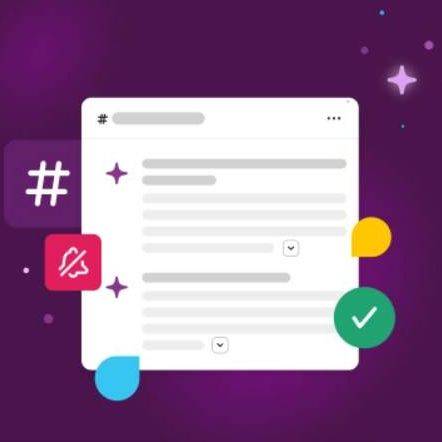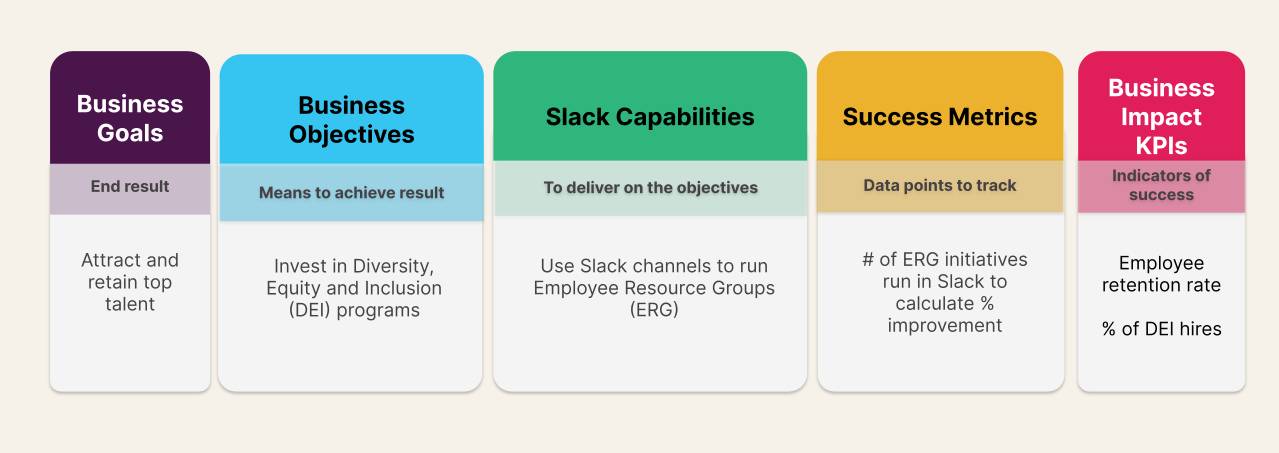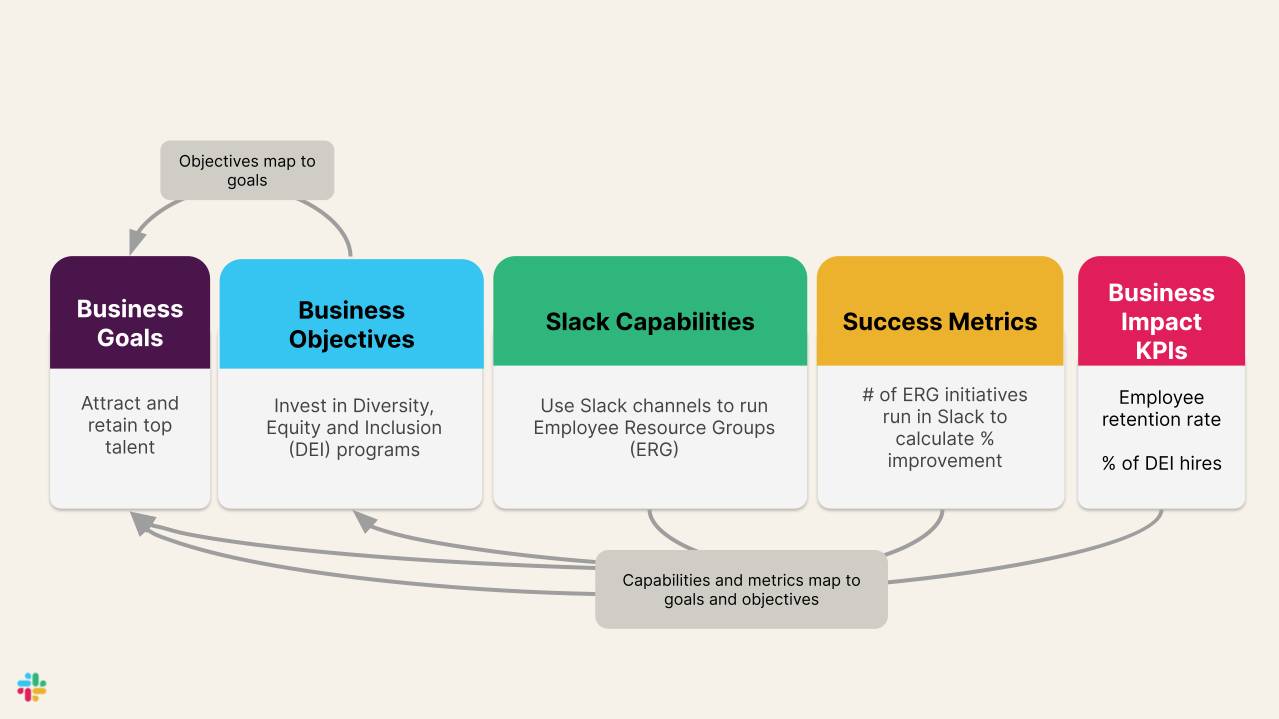Quantify Current Value and Goals
Learning Objectives
After completing this unit, you’ll be able to:
- Create a value map that articulates how Slack is helping a team meet their business objectives.
- Host discovery workshops to gather and analyze data insights and quantify the business impact of Slack.
Three Phases of the Slack Value Realization Methodology
In the previous unit, you learned about the Slack value realization methodology. It consists of three phases.
-
Phase 1: Quantify: Understand your team's business goals and match Slack features and metrics to show how using Slack helps achieve those goals.
-
Phase 2: Optimize: Analyze current metrics and identify areas for improvement. Develop a value roadmap to optimize your Slack instance using best practices.
-
Phase 3: Collaborate: Create a value summary that includes success stories and suggestions to help improve value and get business leaders more involved.
This unit focuses on the first phase-quantify. You take a deeper dive into the other two phases in the next unit.
Phase 1: Quantify Value
The quantify value phase is a time for you and your stakeholders to agree on business goals and your definition of value for the company. You can see how your teams are using Slack now and then match Slack features and usage data to their goals.
Key milestones during this phase include:
- Build a partnership with executive sponsors and business leaders to understand and agree on important business goals.
- Create a Slack value map based on that shared understanding of value.
- Conduct discovery workshops to quantify the business impact of current Slack use by a line of business.
Create a Slack Value Map
Creating a value map helps you articulate the impact of how Slack helps you realize business goals.
A Slack value map can be a powerful tool to understand the value your organization has already realized from Slack, track real-time value when implementing improvements, and plan a roadmap for future improvement. It can show best practices and examples from different parts of your organization, helping you take advantage of what’s working well in one area and find ways to fix a problem or fill a need in another area.

Here are some benefits of creating a value map.
- Align value with business goals.
- Consider revenue growth, customer satisfaction, cost savings, efficiency gains, and operational excellence.
- Consider revenue growth, customer satisfaction, cost savings, efficiency gains, and operational excellence.
- Define objectives.
- What are the means to achieve results that are strategic, actionable, and measurable?
- What are the means to achieve results that are strategic, actionable, and measurable?
- Identify Slack capabilities.
- Features and products in the productivity platform that enable the delivery of objectives.
- Features and products in the productivity platform that enable the delivery of objectives.
- Measure success.
- Establish success metrics that track progress against business goals and key performance indicators (KPIs).
- Establish success metrics that track progress against business goals and key performance indicators (KPIs).
Check out the following interactivity to learn more about what elements to include in your Slack value map.
Let’s say you’ve gone through all the steps and your team realizes that a more diverse workforce will help you meet your business objectives. Here’s what your value map could look like.

Follow Best Practices When Creating Value Maps
Value maps can be different based on your organzation’s goals, but they all share common best practices. Here’s a few to keep in mind.
- The value map should be a living document that evolves as your business and priorities change.
- Present the value map to key stakeholders for validation. The validated value map will serve as the foundation for all future value conversations.
- You can access Slack analytics data in either your workspace or org analytics dashboard, SCIM analytics, or message activity analytics to help map value.

After creating a value map, validate it with business leadership and key stakeholders. Ask validation questions to ensure alignment with overall business strategy and identify areas for improvement. Remember, the value map should be a living document that can be treated like a "North Star” and should evolve and iterate as your business and priorities change.
Download and save this template to complete your own Slack value map.
Conduct Discovery Workshops
Surveys are a great way to understand and measure your end user needs, preferences, and usage patterns. Surveys are best conducted pre- or post-launch of Slack, or on a regular cadence (quarterly, annually, and so forth).
Four Steps for Discovery
Follow these steps to gather relevant information for your Slack value map.
Step 1: Create a Survey Planning Document
The first step in the survey process is to create a survey planning document. This document serves as an internal reference guide that outlines the survey goals, target end users, messaging templates, and the link to the survey. By sharing this document with your team, you can ensure alignment and collaboration throughout the survey process.
Step 2: Design Your Survey
Once you've established your survey goals and target audience, it’s time to design your survey. We recommend that you:
- Keep the survey concise (up to 10 questions) and vary the question types to maintain respondent engagement.
- Ask questions that provide insight into the goals of your value map and that are quantifiable.
- Conduct your survey within Slack, and export and manage your responses. See how at Automations: Collect information using a simple form.
Here are some sample survey questions you can include.
- How essential is Slack to your day-to-day work?
- With Slack, how productive is your team?
- Moving from live meetings to Slack, how much time has your team saved?
- On average, how much time has Slack given you back in your week?
- Do you think Slack has improved the culture of your team?
- Slack has helped reduce internal emails by ____?
- Please provide a brief description of any specialized workflows or apps your team has developed within Slack and how they're being used today.
- Has Slack helped you resolve issues faster?
Step 3: Launch Your Survey
With your survey designed, it’s time to launch it to your end users. We recommend that you:
- Request an internal stakeholder to send the survey in a prominent channel or distribute it via email using the proposed messaging.
- Offer a gift for completing the survey or set a due date for responses to increase participation rates.
Step 4: Conduct 1:1 Interviews
As responses start coming in, consider conducting one-to-one interviews with selected end users to gain deeper insights into their Slack usage. These interviews can provide valuable context and personal stories that enrich the survey data. We recommend that you:
- Consider reaching out to differently leveled roles to capture insight across a business unit.
- Conduct your interviews via huddles, where it's easy to simultaneously keep notes in thread, share a canvas, share your screen, add emoji, and more. See how at Use huddles in Slack.
Here are some example interview questions you can include.
- Can you give an overview of your role/what you’re responsible for?
- What are some initiatives/areas of focus and strategic objectives that are top of mind?
- What challenges/barriers stand in the way of your goals?
- What tools do you use to collaborate with others? How do you use the tools? What do you like/dislike?
- How do you use Slack? To achieve which business purposes(es)?
- Walk us through an important process. How long does this process currently take, from beginning to end (for example, number of hours, days, weeks, and so on). Are there any frequent struggles with this important process (for example, it’s too manual, risk errors, needs several rounds of QAing, and so on)?
Once the survey and interviews are complete, it’s essential to analyze the results and present them to your stakeholders. The insights gathered from the survey will inform your next steps for improving end user experience and enablement, and will provide qualitative analysis to gain valuable insights and drive informed decision-making.
With a value map and insights from surveys and interviews, you'll have a strong understanding of existing Slack usage, how that utilization impacts KPIs, and the resulting value that is being realized by your organization.
Resources
- Slack Skills Badge: Use Slack analytics to drive adoption and engagement
- Slack Skills Badge: Manage projects in Slack
- Slack solutions by line of business
- Slack workflow automation
- Demo: Slack Sales Elevate (Sign-up required)
- Download: Slack’s value map template
- Slack Help Center: Automations: Collect information using a simple form
- Slack Help Center: Use huddles in Slack
